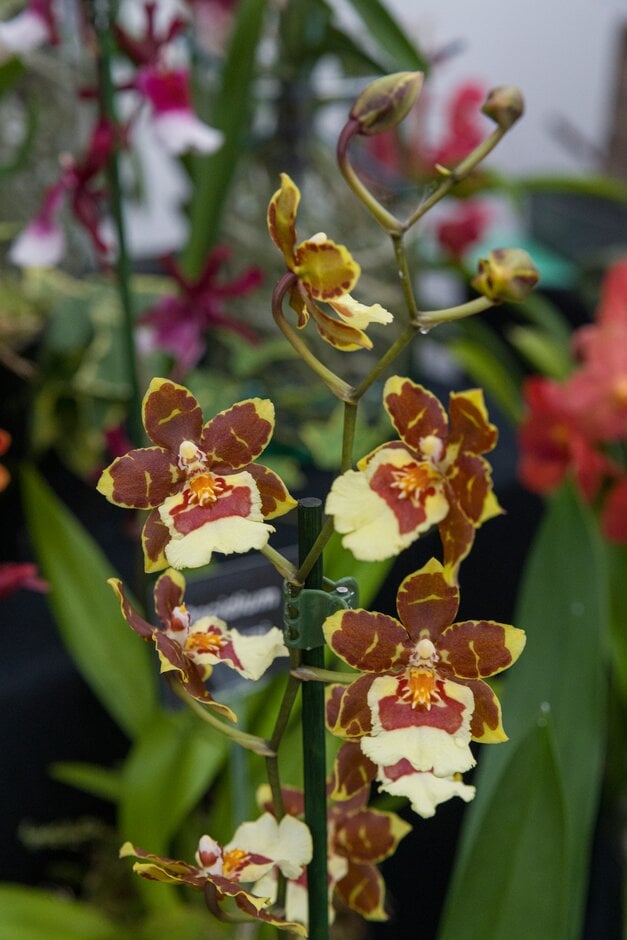Oncidium Jungle Monarch gx
dancing lady orchid Jungle Monarch gx
A medium-sized, epiphytic orchid with strap-shaped, 30-40cm long, evergreen leaves. New growth appears from the swollen stem base - pseudobulb, a storage organ for water and nutrients. Pseudobulbs are oval shaped, slightly flattened around the top and partially covered by one or two pairs of green, leafed sheaths. New flowering stems arise from axils of young mature pseudobulbs and the leafed sheaths. Up to 60cm long, upright flowering stems carry large number of 5cm large, scented flowers. Star-shaped flowers are pale yellow with darker, brow-red markings and white lip

Size
Ultimate height
0.1–0.5 metresTime to ultimate height
5–10 yearsUltimate spread
0.1–0.5 metresGrowing conditions
Moisture
Well–drainedpH
NeutralColour & scent
| Stem | Flower | Foliage | Fruit | |
| Spring | Brown Red White Green Yellow | Green | ||
|---|---|---|---|---|
| Summer | Brown Red White Green Yellow | Green | ||
| Autumn | Green | |||
| Winter | Brown Red White Green Yellow | Green |
Position
- Partial shade
Aspect
East–facing or South–facing or West–facing
Exposure
Sheltered Hardiness
H1ABotanical details
- Family
- Orchidaceae
- Native to GB / Ireland
- No
- Foliage
- Evergreen
- Habit
- Clump forming, Columnar upright
- Potentially harmful
- Skin allergen. Wear gloves and other protective equipment when handling
- Genus
Oncidium are a large genus of epiphytic orchids; mature plants form clumps of ovoid to conical pseudobulbs, each with 1-3 mid-green, variably-shaped, leathery leaves arising from the tips. Flower panicles from the bases of the pseudobulbs widely differ in colour and shape
- Name status
Accepted
How to grow
Cultivation
Grow in an open bark-based orchid compost with addition of perlite, sphagnum moss or coir. Provide enough bright filtered light, but keep away from direct sunlight or a heating source. Ideal temperatures are around 13°C minimum at night and up to maximum 25 °C during day. Water regularly, when the pot feels light when lifted. Ensure that all water drains away, preventing the plant sitting wet. Orchid fertiliser can be applied regularly throughout the growing season. Reduce watering and feeding in winter months. The orchid will naturally produce aerial roots, growing outside of the pot. As with many orchids, they grow best when well-established and slightly pot-bound. Re-potting should be only done if the plant overgrows its container or before the potting mix starts to deteriorate - approximately once in 2-3 years. For more notes, see oncidium orchid (cool) cultivation
Propagation
Mature plants may be divided when the plant overgrows its container. Each division should have at least 3 older growths with a sufficient amount of stored energy and water, to support new growth and reduce stress after repotting
Suggested planting locations and garden types
- Houseplants
- Conservatory and greenhouse
Pruning
No pruning required. Remove the flowering stem once finished flowering
Pests
May be susceptible to mealybugs, aphids and scale insects
Diseases
Generally disease-free
Get involved
The Royal Horticultural Society is the UK’s leading gardening charity. We aim to enrich everyone’s life through plants, and make the UK a greener and more beautiful place.